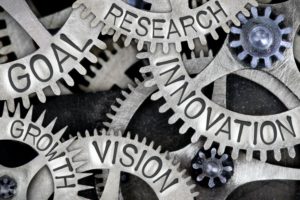What if I said I could help you achieve audacious new goals with your organization without turning it upside down? That is, with the existing employees, structure, and assets?
Would you be interested?
I hope so because I know it can be done. I’ve been able to achieve amazing results with organizations I’ve led by making a few changes that redirected the team with a new plan and a new vision.
In my case the change took place in business environments, but the principle applies to any type of organization. I’ll use education as an example to prove the point.
A school within a school
I recently had the opportunity to visit Lake Worth Community High School in Florida’s Palm Beach district. I spent a good part of a day there, meeting the principal, Dr. Elvis Epps, students, and teachers, and was able to appreciate the positive change that is taking place.
Lake Worth, which serves 2,400 students grades 9 to 12, faces the common challenges of inner city schools. Minority students represent 87.9% of the student body. More than 82% come from economically disadvantaged families. Home-internet access is not commonplace, making it difficult for many students to do their homework if online access is required.
Yet in this same school, with the same teachers, same students, same classrooms, and teaching the same basic curriculum as other schools, a school-within-a-school program that started here in August is poised to deliver big change. It already has in several schools in Georgia.
And, to my point, with minimal changes to the organization.
The secret sauce
The one difference, what I call the secret sauce, is augmenting the basic curriculum with experiential learning, based on real business-case studies, to connect academics with real life.
For example, Florida Power & Light, a local company, created a business case to help Lake Worth students understand the cost effectiveness of solar power versus natural gas.
Another company, Arby’s, created a business case asking the students what can the company do to get more people of their age group to buy from their chain.
I was blown away watching 15 and16-year-old Lake Worth students talking about the role of customer service, the costs and benefits of one type of energy versus another, and the importance of cultural agility and systems-thinking in the information era.
Now, here’s the kicker: cultural agility and systems thinking are two of the four cognitive capacities that, according to Northeastern University President Joseph A. Aoun, can help learners become “robot-proof,” to use his term. I talked about that in a previous article, but I don’t think that’s where the students learned it.
They learned it through 3DE.
What is 3DE?
Now let me talk about the program.
3DE Schools is the result of a shared vision by business and education leaders, together with Junior Achievement, to help challenged schools achieve better results in terms of attendance, learning, and graduation rates, by introducing minimal but effective change.
In this case, the big difference is the experiential learning I mentioned before. Jack Harris, a veteran JA leader and innovator, headed the effort from idea to reality and now serves as president and CEO of 3DE Schools.
3DE launched in 2015 in Atlanta’s Benjamin Banneker High School in partnership with Fulton County Schools in Georgia, Junior Achievement USA, and Junior Achievement of Georgia.
As of this school year, 3DE is already working in 13 schools (10 in Georgia and 3 in Florida). Next year it will open in an additional 8 schools (4 in Georgia and 4 in Florida), while it plans its expansion to other US markets.
It’s working!
While 3DE is too new at Lake Worth to tally results, at Banneker High School, where it has been in operation for four years, the results are nothing short of amazing.
- Increased graduation rates among 3DE students from 62% (class of 2015) to 92% (class of 2019)
- College enrollment rate increased to 88%
- Significantly reduced absenteeism by an aggregate 38% across the initial 6 pilot schools
The startup model
I used 3DE to illustrate one of the ways you can bring significant change to an organization without turning it upside down.
In this case, the method involves creating a startup (3DE Schools) within a larger organization (JA), but giving it enough independence so it can do things differently, as the market demands.
In my experience, I found that’s an excellent way to attack markets that are new, changing, or underserved. We did this with great success at AT&T when we created the Internet of Things (IoT) business unit. I found that both organizations can coexist and eventually, in some cases, the startup can get integrated into the bigger organization as the concept matures.
I congratulate the JA USA board leadership for their courage and wisdom to make this happen inside an organization with a 100-year legacy. This is an example of entrepreneurship (one of JA’s main teachings) at its best.
The leadership takeaway
There are a couple of takeaways for LinkedIn readers from all this.
First, the premise that making significant change does not necessarily require an organization overhaul. Strong leaders with a clear vision, the audacity to try new ways to do things, and possessing the communication skills to motivate teams can achieve great things with minimal changes by using teams and assets already in place.
The other lesson is the value of starting a small and relatively independent organization within the larger enterprise (like a company-within-a-company or a school-within-a-school) as a way to try new things without tearing the entire organization apart.
Of course, there is not a one-size-fits-all formula in terms of how extensive the changes need to be. Every situation is different and has to be assessed on its own. Some assignments may require more or fewer changes. However, my overall experience is that you can achieve great results by making minimal changes, as 3DE has done.
Here’s my recommendation to you: When you are assigned to a new organization, resist thinking that a complete overhaul is required.
Make sure you understand the situation. Make sure you get to know the people and the organization. Make time to listen to customers. And then change only what is required to drive outstanding performance.
If you do that kind of initial homework, my bet is that you’ll find that by introducing minimal changes and a compelling vision you’ll be able to get almost immediate results.
As a plus, you’ll be rewarded by an uplift in team morale and engagement that is likely to fuel additional success.



